An english version of this page will be made available soon.
You may wish to go to the english homepage.
You may wish to go to the english homepage.
Digital terrestrial television or DTT replaced traditional television. Instead of being transmitted in traditional (analogue) form, television in Portugal is now being transmitted using digital signals, with reception still provided by exterior aerials, and, in areas with better reception, indoor aerials.
With DTT:
In the future these channels will only be broadcast in high definition format (HD), so it is advisable to acquire equipment now that is compatible with this format.
For further information, consult the DTT Websitehttps://tdt.telecom.pt/ .
DTT is already available throughout Portugal. In most areas, MEO - Serviços de Comunicações e Multimédia offers this service using terrestrial reception - "DTT zones", but in some areas coverage is provided using other means, including satellite (DTHDTT) - "DTH zones". This is because, in technical terms, it is virtually impossible and economically unfeasible to cover 100 percent of the population using terrestrial transmissions (given use of a single frequency network).
Therefore, to switch to DTT, the first step is to find out what type of coverage there is where you live, i.e. you need to find out whether you live in a DTT zone or DTH zone.
For further information, consult the DTT Website https://tdt.telecom.pt/.
Call 800 200 838 (freephone) or visit the DTT website provided by MEO - Serviços de Comunicações e Multimédia. Then you can check the type of coverage you have by entering your address and your postcode.
Check the type of DTT access available where you live, before you purchase any equipment.
For further information, consult the DTT Website https://tdt.telecom.pt/.
Fist of all, find out whether terrestrial DTT reception is available where you live - call 800 200 838 (freephone) or check on the DTT Website https://tdt.telecom.pt/.
If you do have terrestrial DTT reception, you need a television set that is able to receive digital signals. Some television sets are already designed for this purpose, but others must be connected to a set-top box.
If your television set is capable of receiving DVB-T and decoding MPEG-4/H.264 video signals, then you are ready to receive DTT.
If your television set is not compatible, check if your TV has a SCART or HDMI socket. If it does, you will need to acquire a DTT set-top box and connect it to the television set and also to your aerial.
If your television set is very old and does not have any of these inputs/sockets, you can acquire a set-top box with integrated modulation or an RF modulator.
Alternatively, you could acquire a new television set with DVB-T and MPEG4/H.264.
DTT reception equipment is available in most electrical stores. However, you should always confirm, if necessary with the help of a technician, if the equipment's characteristics enable DTT reception in Portugal.
Under a protocol agreed with ANACOM, DECO is conducting an ongoing series of tests to compare different set-top boxes for DTT. See the results of these tests http://www.deco.proteste.pt/tecnologia/televisores.
In summary, you do not need to acquire any equipment if:
For further information, consult the DTT Website https://tdt.telecom.pt/.
First of all, confirm that you live in an area with satellite reception - call 800 200 838 (freephone) or check on the DTT Website https://tdt.telecom.pt/.
In some areas of the country, coverage is provided by satellite. This is because, in technical terms, it is virtually impossible and economically unfeasible to cover 100 percent of the population using terrestrial transmissions (given use of a single frequency network). As a result, provision was made that a percentage of the population would be given access to the service using satellite (DTH), as long as the conditions provided were comparable to the terrestrial access provided to populations living in "DTT zones".
If you are in an area with satellite coverage, you will need to acquire a DTH kit in order to be able to continue receiving television, available from points of sale appointed by MEO - Serviços de Comunicações e Multimédia in municipalities with satellite coverage http://tdt.telecom.pt/Documents/suporte/equipamentos/lista-pontos-venda-tdt-complementar.pdf. The DTH kit includes a DTH set-top box, a remote control, connection cables and a smartcard.
In certain situations, you can request your equipment by writing to the following address:
TDT
Apartado 1501
EC Devesas (Vila Nova de Gaia)
4401-901 Vila Nova de Gaia
The DTH set-top box is connected in the same way as DTT set-top boxes: connect the cable from the satellite dish to the set-top box and then connect the set-top box to your television set using a SCART or HDMI cable. The channels are tuned automatically and you can then start using the remote control that comes with the set-top box.
For further information, consult the DTT Website https://tdt.telecom.pt/.
DTT transmissions in Portugal use DVB-T technology and MPEG-4/H.264 video compression.
Therefore, to receive DTT broadcasts, the technical specifications of your equipment must meet at least two conditions:
If your product does not meet these two conditions, you will need to do the following:
Before purchasing any equipment make sure that you have direct access to DTT in your home. If DTT is not available, or provision is limited, you may need different equipment to receive DTT (for example, a satellite dish and a set-top box for satellite reception). For further information, check with MEO - Serviços de Comunicações e Multimédia, through the DTT Website https://tdt.telecom.pt/ or by calling 800 200 838 (freephone).
DTT is a free service, it is only necessary have proper equipmenthttps://www.anacom.pt/render.jsp?contentId=935759.
For further information, consult the DTT Website https://tdt.telecom.pt/.
If you have a simple television set (analogue) or an integrated digital television that can only decode video in MPEG2 format, then you will need an external set-top box.
When choosing a set-top box, make sure it meets the following characteristics:
In areas covered by alternative means to DTT (e.g., satellite - areas of DTH reception), check with MEO - Serviços de Comunicações e Multimédia, by calling 800 200 838 (freephone) or checking the DTT Website https://tdt.telecom.pt/, since the equipment needed is different from the equipment indicated above, used for terrestrial DTT reception.
There are 3 types of set-top boxes:
The set-top box is connected between the aerial socket and your television set. Disconnect you current aerial cable from your television set and connect it to the set-top box. Finally, connect the set-top box to your television set.
In the most common set up, the set-top box and your television set should both have SCART sockets (see figure 1), so that you can connect them using a SCART-SCART cable which is suitable for both devices.
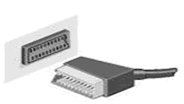
Figure 1
If your television set and set-top box both have HDMI sockets (see Figure 2), you should use this connection, for better sound and picture.

Figure 2
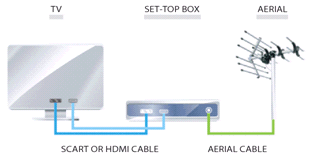
Figure 3
If your television set does not have any of these sockets, you can:
DTH set-top boxes are connected in the same way as DTT set-top boxes: connect the cable from the satellite dish satellite to the set-top box and then connect the set-top box to your television set using a SCART or HDMI cable.
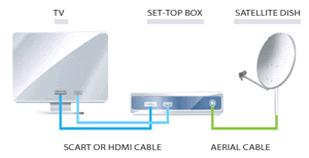
Figure 4
For further information, consult the DTT Website https://tdt.telecom.pt/.
In order to watch different TV channels on different television sets, generally, you will need a separate set-top box for each television. If the television sets are not integrated, you will need to acquire external set-top boxes for each one.
You can also choose to distribute the signal to multiple television sets from a single point. However, with this solution, we suggest you contact a technician, otherwise you might not be able to watch different TV channels simultaneously on different television sets.
For further information, consult the DTT Website https://tdt.telecom.pt/.
You can still use your DVD or video player/recorder with DTT. Usually, DTT set-top boxes have additional outputs which can be connected to a recorder or player. Some have a hard drive which means you can record, stop and restart broadcasts.
For further information, consult the DTT Website https://tdt.telecom.pt/.
If you subscribe to a paid television services, normally, you will not need to access DTT.
However, you should check that all your televisions sets are connected to the subscription television service. Otherwise, you should get them ready for DTT. The same applies if you want to stop subscribing to paid television services.
For further information, consult the DTT Website https://tdt.telecom.pt/.
It is not essential to have DTT reception equipment that supports high definition, but it is recommended.
According to the DTT model adopted in Portugal, free-to-air channels will be broadcast in standard definition (SD) with shared transmission of these channels in high definition (HD). However, the current transmission capacity of the DTT service is not yet sufficient for all programmes to be broadcast in high definition simultaneously. Much greater transmission capacity is needed to transmit a programme in high definition than to transmit the same programme in standard definition.
On the other hand, technological developments indicate that, in the future, transmission will be high definition only.
To access DTT in high definition, you will need to have an integrated digital television set or an external set-top box capable of high definition decoding.
You will also need to have a television set which is high definition ready, i.e. with a minimum vertical resolution of 720 lines (720p). These televisions are identified with the label "HD Ready" or "Full HD", the latter corresponding to a vertical resolution of 1080 lines.
If you have or you plan to acquire reception equipment that only supports standard (SD) definition transmissions, you could be left unable to access DTT services if transmissions become exclusively HD.
For further information, consult the DTT Website https://tdt.telecom.pt/.
It is not currently essential, but highly advisable.
The technological developments indicate that, in the future, transmission will be high definition only.
If you have or you plan to acquire reception equipment that only supports SD transmissions, you could be left unable to access DTT services if transmissions become exclusively HD.
For further information, consult the DTT Website https://tdt.telecom.pt/.
Users who do not live within an area with DTT coverage (terrestrial coverage area) are eligible to receive a reimbursement from MEO - Serviços de Comunicações e Multimédia on the cost of acquiring up to two set-top boxes per home, provided they have no subscription television service (pay TV). This regime for reimbursement will be effective until 9 December 2023.
To obtain the reimbursement, users should acquire a DTH Kit from MEO - Serviços de Comunicações e Multimédia. The DTH Kit includes a DTH set-top box, remote control, connection cables and a smartcard.
To check if you live in an area with digital reception only available through satellite, check the DTT Website https://tdt.telecom.pt/ or call freephone 800 200 838.
Users can obtain reimbursement on the purchase of the first and second DTH Kits in one of two ways:
1. acquire the equipment for its full value (77 euros) and receive a refund for the reimbursement amount (47 euros) after sending the request form http://tdt.telecom.pt/Documents/suporte/custos/mod-c1001138-programa-comparticipcao-equipamento-tdt-complementar.pdf and supporting documents requested by MEO - Serviços de Comunicações e Multimédia to the PO Box address of the DTT Service. The following documents are required:
2. order the DTH Kit and, provided that all requirements for reimbursement are met, collect the equipment from the store, paying only 30 euros per kit (up to two per home). Equipment will be available for collection within 5 working days (for 95 percent of requests), following confirmation from MEO - Serviços de Comunicações e Multimédia.
PO Box address of the DTT Service:
TDT
Apartado 1501
EC Devesas (Vila Nova de Gaia)
4401-901 Vila Nova de Gaia
For further information, consult the DTT Website https://tdt.telecom.pt/.
The value of the DTH Kit after reimbursement is 30 euros (unit value for the first and second Kits); users can obtain the kit with reimbursement in one of two ways:
The regime for reimbursement will be effective until 9 December 2023.
Additional DTH Kits (from the third kit, per address or if you have pay TV), cost 96 euros and are not covered by any reimbursement.
These values may be reviewed by ANACOM, particularly in light of changes in equipment prices.
For further information see the DTT Portal https://tdt.telecom.pt/ or call freephone 800 200 838.
If you have an older television set without a SCART socket to connect to an external set-top box, you can use an RF modulator or an external set-top box with integrated RF modulator, which transforms the signal so that it can be connected directly to your television set using the standard aerial socket, as shown below:
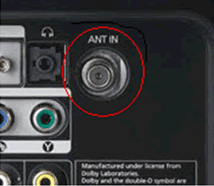
For further information, consult the DTT Website https://tdt.telecom.pt/.
TDT - Ações de monitorizaçãohttps://www.anacom.pt/render.jsp?contentId=1355645 (DTT - Monitoring Actions) is a tool provided by ANACOM that can be used to consult the different DTT signal monitoring activities. The tool provides access to the reports on the different monitoring actions undertaken by ANACOM's teams on the ground, with information on the distribution and geographical focus of these actions, the date they took place, the type of problems identified and the procedures undertaken to ensure resolution. Actions can be searched by initiating party (actions taking place upon ANACOM's initiative or following complaints received from organisations or private individuals), by cause of problems and by type of resolution. In geographical terms, information can be searched by district, municipality or parish.
The results can be presented in a table, map or chart.
The digital terrestrial television (DTT) TV/box must be re-tuned when a blank screen appears on the television.
Learn how to tune in herehttps://www.youtube.com/embed/9fESWKW1tig?rel=0&autoplay=1.
To tune in to the new digital terrestrial television (DTT) channels when you lose the picture on your TV, simply tune back in (automatically or manually) using your equipment (box/TV) controls to continue receiving DTT broadcasts.
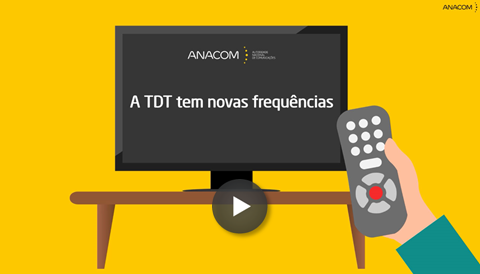 https://www.youtube.com/embed/9fESWKW1tig?rel=0&autoplay=1
https://www.youtube.com/embed/9fESWKW1tig?rel=0&autoplay=1
Any questions you may have about the tuning of channels for digital terrestrial television (DTT) reception may be answered by consulting the digital television area (Alterações da rede TDThttps://www.anacom.pt/render.jsp?categoryId=410664) or by calling the DTT 800 102 002 toll-free helpline, available every day from 9am to 10pm.